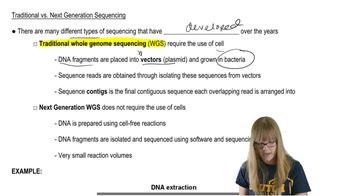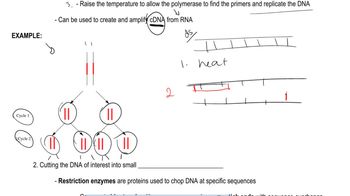List the advantages and disadvantages of using plasmids as cloning vectors. What advantages do BACs and YACs provide over plasmids as cloning vectors?
Table of contents
- 1. Introduction to Genetics51m
- 2. Mendel's Laws of Inheritance3h 37m
- 3. Extensions to Mendelian Inheritance2h 41m
- 4. Genetic Mapping and Linkage2h 28m
- 5. Genetics of Bacteria and Viruses1h 21m
- 6. Chromosomal Variation1h 48m
- 7. DNA and Chromosome Structure56m
- 8. DNA Replication1h 10m
- 9. Mitosis and Meiosis1h 34m
- 10. Transcription1h 0m
- 11. Translation58m
- 12. Gene Regulation in Prokaryotes1h 19m
- 13. Gene Regulation in Eukaryotes44m
- 14. Genetic Control of Development44m
- 15. Genomes and Genomics1h 50m
- 16. Transposable Elements47m
- 17. Mutation, Repair, and Recombination1h 6m
- 18. Molecular Genetic Tools19m
- 19. Cancer Genetics29m
- 20. Quantitative Genetics1h 26m
- 21. Population Genetics50m
- 22. Evolutionary Genetics29m
18. Molecular Genetic Tools
Genetic Cloning
Problem 10
Textbook Question
Outline the roles played by restriction enzymes and vectors in cloning DNA.
 Verified step by step guidance
Verified step by step guidance1
Understand that restriction enzymes, also known as restriction endonucleases, act as molecular scissors that recognize specific DNA sequences and cut the DNA at or near these sites. This allows scientists to cut DNA into manageable fragments for cloning.
Recognize that vectors are DNA molecules used as carriers to transfer foreign genetic material into a host cell. Common vectors include plasmids, bacteriophages, and cosmids.
Learn that after the restriction enzyme cuts both the DNA fragment of interest and the vector DNA with compatible ends, these fragments can be joined together using an enzyme called DNA ligase, forming recombinant DNA.
Know that the recombinant vector is then introduced into a host organism (usually bacteria) through a process called transformation, where the host cells take up the recombinant DNA and replicate it, producing many copies of the inserted gene.
Appreciate that the combined action of restriction enzymes and vectors enables the precise insertion and propagation of specific DNA sequences, which is fundamental for gene cloning, genetic engineering, and molecular biology research.
 Verified video answer for a similar problem:
Verified video answer for a similar problem:This video solution was recommended by our tutors as helpful for the problem above
Video duration:
37sPlay a video:
Was this helpful?
Key Concepts
Here are the essential concepts you must grasp in order to answer the question correctly.
Restriction Enzymes
Restriction enzymes are proteins that cut DNA at specific sequences, known as recognition sites. They act as molecular scissors, enabling scientists to cut DNA into precise fragments for cloning. These enzymes are essential for isolating the gene or DNA segment of interest.
Recommended video:
Guided course

Mapping with Markers
Vectors
Vectors are DNA molecules used to carry foreign DNA into a host cell during cloning. Common vectors include plasmids and viruses, which can replicate independently within the host, ensuring the inserted DNA is copied and expressed.
Recommended video:
Guided course

Traditional vs. Next-Gen
DNA Cloning Process
DNA cloning involves inserting a DNA fragment into a vector using restriction enzymes, then introducing this recombinant DNA into a host cell. The host replicates the vector, producing multiple copies of the DNA fragment for further study or use.
Recommended video:
Guided course

Genetic Cloning
Related Videos
Related Practice
Textbook Question
1287
views


